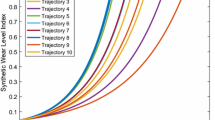Abstract
The paper studies time series of dynamical systems for failures, applying data-driven machine learning techniques, such as clustering and tipping point analysis. Artificial data with known properties and real systems case studies are considered, with diverse patterns of time series. Applicability of various techniques is discussed. The proposed methodology may be useful in industrial and geophysical applications, where sensor records are available for data-driven failure analysis.













Similar content being viewed by others
References
P. Lara-Benitez, M. Carranza-Garcia, J. Riquelme, An experimental review on deep learning architectures for time series forecasting. Int. J. Neural Syst. 31(3), 2130001 (2021)
X. Sun, K. Chakrabarty, R. Huang, Y. Chen, B. Zhao, H. Cao, Y. Han, X. Liang, L. Jiang, System-level hardware failure prediction using deep learning. In: Proceedings of the 56th Annual Design Automation Conference 2019, Las Vegas, NV, USA (2019)
C. Su, L. Tsai, S. Huang, Y. Li, Deep learning-based real-time failure detection of storage devices, international conference on applied human factors and ergonomics, advances in artificial intelligence, software and systems. Engineering 965, 160–168 (2019)
T. Lenton et al., Tipping elements in the Earth’s climate system. Proc. Natl. Acad. Sci. USA 105(6), 1786–1793 (2008)
V. Livina, F. Kwasniok, G. Lohmann, J. Kantelhardt, T. Lenton, Changing climate states and stability: from Pliocene to present. Clim. Dyn. 37(11–12), 2437–2453 (2011)
V. Livina, F. Kwasniok, T. Lenton, Potential analysis reveals changing number of climate states during the last 60 kyr. Clim. Past 6, 77–82 (2010)
V. Livina, T. Lenton, A modified method for detecting incipient bifurcations in a dynamical system. Geophys. Res. Lett. 34, L03712 (2007)
V. Livina, E. Barton, A. Forbes, Tipping point analysis of the NPL footbridge. J. Civ. Struct. Heal. Monit. 4, 91–98 (2014)
M. Perry, V. Livina, P. Niewczas, Tipping point analysis of cracking in reinforced concrete. Smart Mater. Struct. 25(1), 015027 (2016)
V. Livina, A. Lewis, M. Wickham, Tipping point analysis of electrical resistance data with early warning signals of failure for predictive maintenance. J. Electron. Test. 36, 569–576 (2020)
J. Prettyman, T. Kuna, V. Livina, Generalized early warning signals in multivariate and gridded data with an application to tropical cyclones. Chaos 29, 073105 (2019)
G. Gan, C. Ma, J. Wu, Data Clustering: Theory, Algorithms, and Applications (SIAM, New Delhi, vol, 2007), p. 20
T. Hastie, R. Tibshirani, J. Friedman, The Elements of Statistical Learning: Data Mining, Inference, and Prediction Springer Series in Statistics. (Springer, Berlin, 2008)
J. Bruno, I. Weiss, Metric axioms: a structural study. Topol. Proceed. 4 (2015)
Z. Chen, S. Ding, K. Zhang, Z. Li, Z. Hu, Canonical correlation analysis-based fault detection methods with application to alumina evaporation process. Control. Eng. Pract. 46, 51–58 (2016)
Z. Chen, S. Ding, K. Zhang, C. Yang, T. Peng, Generalised CCA with applications for fault detection and estimation, IEEE 7th Data Driven Control and Learning Systems Conference, Enshi (China), May 25–27, pp. 545–550 (2018)
Z. Chen, Canonical correlation analysis-based fault detection and process monitoring algorithm MATLAB Central File Exchange (Accessed on 27 Feb 2022) (2020)
V. Livina, G. Lohmann, M. Mudelsee, T. Lenton, Forecasting the underlying potential governing the time series of a dynamical system. Phys. A 392(18), 3891–3902 (2013)
G.E.P. Box, G. Jenkins, Time Series Analysis: Forecasting and Control (Holden-Day, San Francisco, 1976)
H. Bozdogan, Model selection and Akaike’s information criterion (AIC): the general theory and its analytical extensions. Psychometrika 52(2), 345–370 (1987)
E. Clement, Using normalized Bayesian information criterion (BIC) to improve Box-Jenkins model building. Am. J. Math. Stat. 4(5), 214–221 (2014)
S. Hochreiter, J. Schmidhuber, Long short-term memory. Neural Comput. 9(8), 1735–1780 (1997)
Li. Yi, H. Cao, Prediction for tourism flow based on LSTM neural network. Procedia Comput. Sci. 129, 277–283 (2018)
V. Livina, P. Ditlevsen, T. Lenton, An independent test of methods of detecting system states and bifurcations in time-series data. Phys. A 391(3), 485–496 (2012)
H.A. Makse, S. Havlin, M. Schwartz, E. Stanley, Method for generating long-range correlations for large systems. Phys. Rev. E 53(5), 5445–5449 (1996)
G. Sonnenfeld , K. Goebel, J. Celaya, An agile accelerated aging, characterization, and scenario simulation system for gate controlled power transistors, IEEE Autotestcon, 208–215 (2008)
NASA Prognostic data repository, Set 8, thermal aging experiment. https://ti.arc.nasa.gov/tech/dash/groups/pcoe/prognostic-data-repository/ (Accessed on 27 Feb 2022)
Acknowledgments
The paper was developed during the 1-year industrial BSc placement of B.Billuroglu at National Physical Laboratory, funded by Surrey University and the Department for Business, Energy and Industrial Strategy (UK). The idea of studying NASA data was suggested by James Blakesley (NPL). The potential artificial data were simulated by PhD student Joaquin Mesa during his placement at NPL. The authors are grateful to Dr. Greg Sonnenfeld (formerly at NASA) for the useful discussion of the thermal aging experiment, whose public data were used in the paper.
Author information
Authors and Affiliations
Corresponding author
Additional information
Publisher's Note
Springer Nature remains neutral with regard to jurisdictional claims in published maps and institutional affiliations.
Rights and permissions
About this article
Cite this article
Billuroglu, B., Livina, V.N. Full-Cycle Failure Analysis Using Conventional Time Series Analysis and Machine Learning Techniques. J Fail. Anal. and Preven. 22, 1121–1134 (2022). https://doi.org/10.1007/s11668-022-01381-1
Received:
Revised:
Accepted:
Published:
Issue Date:
DOI: https://doi.org/10.1007/s11668-022-01381-1




